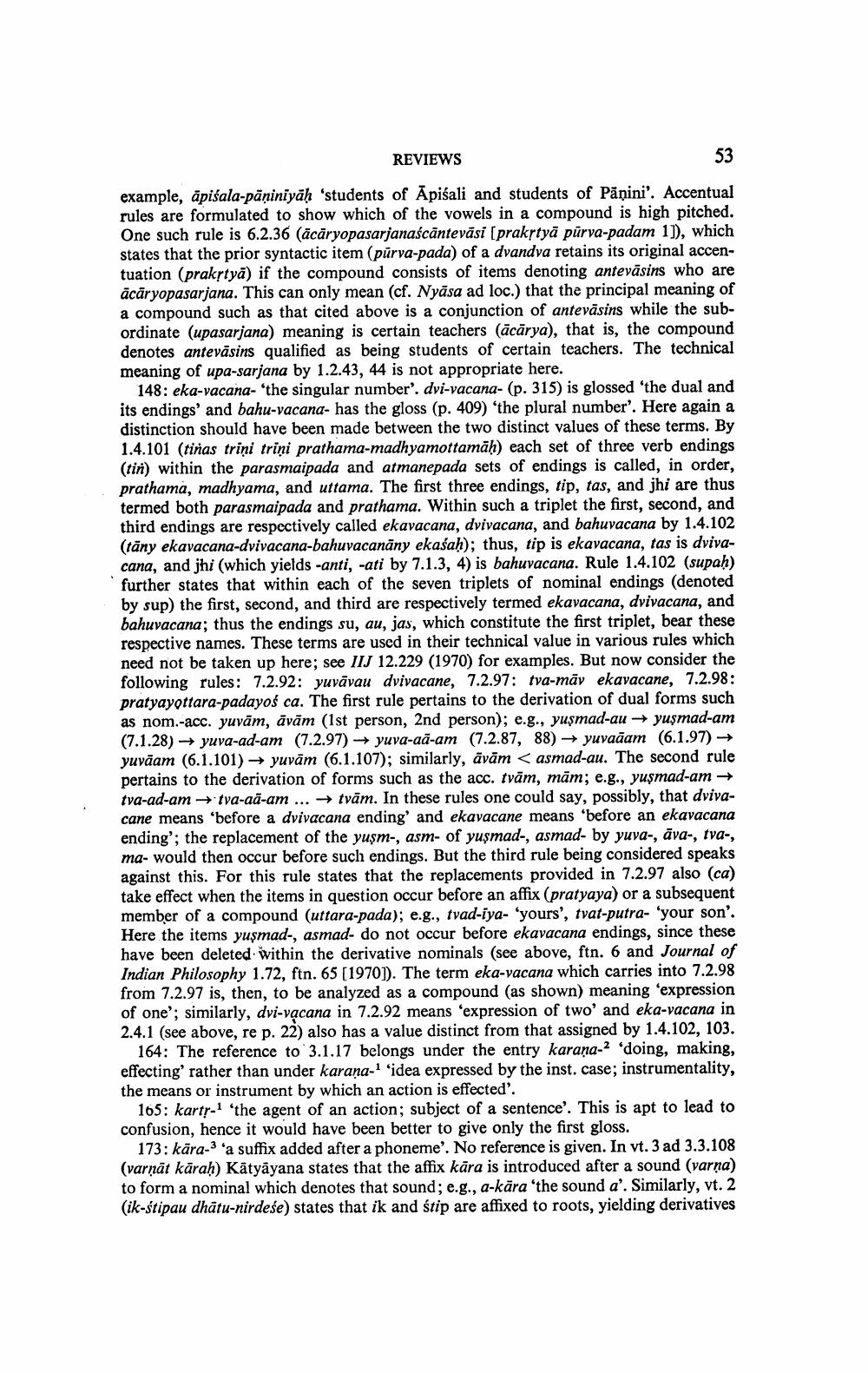________________ REVIEWS example, apisala-paniniyah 'students of Apisali and students of Panini'. Accentual rules are formulated to show which of the vowels in a compound is high pitched. One such rule is 6.2.36 (acaryopasarjanascantevasi (prakrtya purva-padam 1]), which states that the prior syntactic item (purva-pada) of a dvandva retains its original accentuation (prakstya) if the compound consists of items denoting antevasins who are acaryopasarjana. This can only mean (cf. Nyasa ad loc.) that the principal meaning of a compound such as that cited above is a conjunction of antevasins while the subordinate (upasarjana) meaning is certain teachers (acarya), that is, the compound denotes antevasins qualified as being students of certain teachers. The technical meaning of upa-sarjana by 1.2.43, 44 is not appropriate here. 148: eka-vacana- 'the singular number'. dvi-vacana- (p. 315) is glossed 'the dual and its endings' and bahu-vacana- has the gloss (p. 409) 'the plural number'. Here again a distinction should have been made between the two distinct values of these terms. By 1.4.101 (tinas trini trini prathama-madhyamottamah) each set of three verb endings (tin) within the parasmaipada and atmanepada sets of endings is called, in order, prathama, madhyama, and uttama. The first three endings, tip, tas, and jhi are thus termed both parasmaipada and prathama. Within such a triplet the first, second, and third endings are respectively called ekavacana, dvivacana, and bahuvacana by 1.4.102 (tany ekavacana-dvivacana-bahuvacanany ekasah); thus, tip is ekavacana, tas is dvivacana, and jhi (which yields -anti, -ati by 7.1.3, 4) is bahuvacana. Rule 1.4.102 (supah) further states that within each of the seven triplets of nominal endings (denoted by sup) the first, second, and third are respectively termed ekavacana, dvivacana, and bahuvacana; thus the endings su, au, jas, which constitute the first triplet, bear these respective names. These terms are used in their technical value in various rules which need not be taken up here; see IIJ 12.229 (1970) for examples. But now consider the following rules: 7.2.92: yuvavau dvivacane, 7.2.97: tva-mav ekavacane, 7.2.98: pratyayottara-padayos ca. The first rule pertains to the derivation of dual forms such as nom.-acc. yuvam, avam (1st person, 2nd person); e.g., yusmad-au + yusmad-am (7.1.28) > yuva-ad-am (7.2.97) + yuva-aa-am (7.2.87, 88) + yuvaaam (6.1.97) + yuvaam (6.1.101) + yuvam (6.1.107); similarly, avam < asmad-au. The second rule pertains to the derivation of forms such as the acc. tvam, mam; e.g., yusmad-am - tva-ad-am + tva-aa-am ... - tvam. In these rules one could say, possibly, that dvivacane means 'before a dvivacana ending' and ekavacane means 'before an ekavacana ending'; the replacement of the yusm-, asm- of yusmad-, asmad- by yuva-, ava-, tva-, ma- would then occur before such endings. But the third rule being considered speaks against this. For this rule states that the replacements provided in 7.2.97 also (ca) take effect when the items in question occur before an affix (pratyaya) or a subsequent member of a compound (uttara-pada); e.g., tvad-iya- 'yours', tvat-putra- 'your son'. Here the items yusmad-, asmad- do not occur before ekavacana endings, since these have been deleted within the derivative nominals (see above, ftn. 6 and Journal of Indian Philosophy 1.72, ftn. 65 [1970]). The term eka-vacana which carries into 7.2.98 from 7.2.97 is, then, to be analyzed as a compound (as shown) meaning 'expression of one'; similarly, dvi-vacana in 7.2.92 means 'expression of two' and eka-vacana in 2.4.1 (see above, re p. 22) also has a value distinct from that assigned by 1.4.102, 103. 164: The reference to 3.1.17 belongs under the entry karana-2 'doing, making, effecting' rather than under karana-1 'idea expressed by the inst. case; instrumentality, the means or instrument by which an action is effected'. 165: karty-1 'the agent of an action; subject of a sentence'. This is apt to lead to confusion, hence it would have been better to give only the first gloss. 173: kara-3 a suffix added after a phoneme'. No reference is given. In vt. 3 ad 3.3.108 (varnat karah) Katyayana states that the affix kara is introduced after a sound (varna) to form a nominal which denotes that sound; e.g., a-kara 'the sound a'. Similarly, vt. 2 (ik-stipau dhatu-nirdese) states that ik and stip are affixed to roots, yielding derivatives




